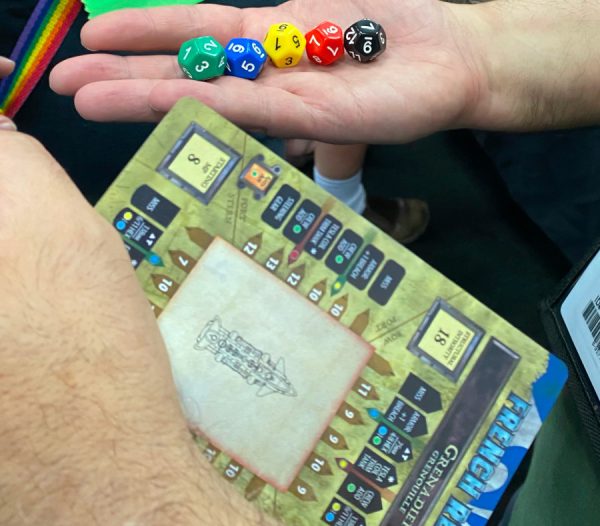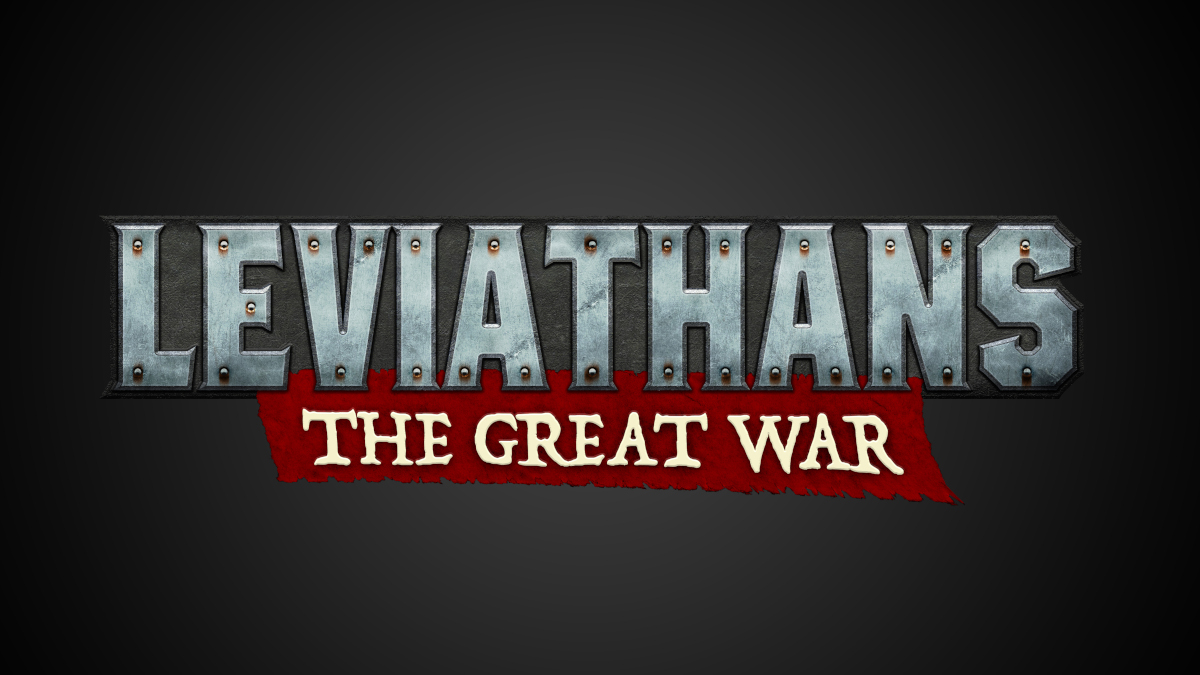While at GenCon, my husband Jason and I had the opportunity to talk with Catalyst Game Labs about their ongoing Kickstarter for Leviathans: The Great War. We had a fantastic time learning more about the game, and my initial hesitance toward it was blown away.

We’ve actually talked about Leviathans here on GeekDad before. I’m excited to see how far it has come since we first took a look a decade ago.
Catalyst Game Labs on Leviathans
Instead of telling you about the game, I’ve decided to let Catalyst’s Randall Bills do it in an excerpt from our interview. It’s a bit long, but worth the read.
- Angela:
- Okay, so tell me about Leviathans because I’ll tell you I’m not much of a gamer of that particular style.
- Randall:
- Well, I will start out since you are a giant fan of BattleTech,
- Angela:
- I am!
- Randall:
- In saying that Leviathans was my love letter to BattleTech. You’re gonna see BattleTech DNA all over, right? It is a very unique, different game. But as you play through it, you’re gonna see a lot of that same type of thing. In fact, why don’t we actually walk over and look at the demo table. So what we have here is alternate era – 1914 right at the start of the Great War. And it’s in classic Harry Turtledove fashion. We took one thing, and we changed it in history, and then how does the world evolve? So in the late 1870s, there was actually a Polish scientist called Rynchowski working on some of this really weird stuff in real life, right? Nothing ever came of that but in OUR universe, he actually created something that he called electroid, which is this fluid that you put electricity through and creates a levitating force. So then they start experimenting with that and usually it’s really hard to go miniature sized much easier go really big. So, as the years roll by some various world powers start playing around with it, but then the pivotal moment is at the Battle of Tsushima. When the Russians and the Japanese battled in the real world. The Japanese won. In OUR world, the Russians were fielding prototype Leviathans, and they won. And that was the shot heard round the world. Everyone realized this was a real thing and everyone starts building like crazy. And so then you plug in the fact that you’re still going to have a World War because they were all building up towards having these massive armies. Okay, so the way the game works is every ship has a ship card, okay? And as you’re, again, very BattleTech oriented, so you’re going to be you have your initiative, you’re then moving sides back and forth. Okay. The slight twist is that you have four types 4-3-2-1, which is battleships, battle cruisers, cruisers and destroyers, and you move all battleships first and then all battle cruisers and then all cruisers and destroyers.
- Angela:
- So it’s really that at least is really similar to how or how we do it in the Harebrained Schemes’ BattleTech game.
- Randall:
- Yes, absolutely. That’s a way to help show the initiative of the bigger guys are just bigger right? They’re harder to maneuver right? And then you get into the battle side battle is simultaneous because I love simultaneous damage so even if I’m blowing something up, that thing’s still gonna have a chance of getting it in.
- Angela:
- I really appreciate your simultaneous damage because otherwise I would have lost last week.
- Randall:
- Exactly so the real magic of the game, if you want to call it that though, is actually in the dice. So, what we have, you know because you know BattleTech, there’s a lot of modifiers. Any tabletop miniature game has a fair amount of modifiers and if you lose all your modifiers then you’ve lost the tactical play in a game. So one of the tricks that we’ve discovered along the way, these are polyhedral dice, D4, D6, D8, D10, D12.

- Angela:
- Oh my gosh, but they’re all D12s. But look at that, they’re numbered like polyhedrals!
- Randall:
- Now for the math geeks in us: If you rolled this versus a polyhedral set, you’d have to roll them 100 times before there’s a variance between the two. That’s how little the variance is. The reason we did all D12s is we were specifically trying to help a vast ocean of board game players that dwarfs tabletop miniature game players. I think there’s a lot of board game players that would love to play tabletop miniature games, but are really intimidated by tons of modifiers. Also a lot of board game players that have never roleplayed so they don’t know the polyhedrals. So what’s a D4, what’s a D6, they’re gonna get stuck in their head. Whereas we color code everything and then you’re not worried about that at all. Okay, so then the way it works, is, I am then grabbing dice color coded to what’s going on. So okay, I’m gonna fire my 75 millimeter short range, I’m grabbing a blue die, okay? I’m looking at Do I have a crew in there? I got a crew on grabbing a green die. I then looked at the target ship. And you have these groups, these ribbons. Okay, so if it moved, I’m grabbing a yellow die if it didn’t move, I’m grabbing a red die.
- Angela:
- So what are doing for people who are colorblind?
- Randall:
- Unfortunately, that we have no fix for. Okay, we have tried and tried and tried. And if somebody has a brilliant way to do it, but literally I have a sample order of like, you know, 20 different colors and 20 different shapes as we tried to figure out how to make that work. We haven’t figured it out yet. (Author’s note: Color Blind people could very easily use standard polyhedrals, but determining which to use may be harder.) I would love to hear how we might do that. So how this works then it is the bell curve combination of these various dice probabilities, that hides all the modifiers within the engine. So you keep all of the modifiers in place. So it still matters, you know, it’s going to be harder to hit here than it is here. So the difference in dice size.
- Angela:
- The fact that this card is practically like a flow sheet makes me very happy in my soul.
- Randall:
- So then all you’re doing is you’re gonna grab a D6 here, okay. You always grab a slot die. So then let’s say that’s what I’m rolling. He’s coming into my arc because again, you have firing arcs just like Battletech does. So I’m gonna roll that I’m gonna add that together. There’s an eight on the four (the four location on the ship card). I’m gonna look at the eight on a four right there (on the card). That’s thirteen, so nothing happened.
- Angela:
- That’s just so fast.
- Randall:
- Yeah, so let’s say we got a really good roll. And that means I didn’t roll because I roll terribly.
- Angela:
- Hey, we have something in common!
- Randall:
- So then, I’m gonna mark that off. Okay. And then again, like BattleTech because it’s simultaneous, I circle it, because I still have that this turn. The other reason we circle: let’s say I had that damage and that damage and that damage on a previous turn. Okay. Another reason we circle is because unlike Battletech, there’s a whole crew on the ships so you have a repair phase. So at the end of each phase, you can repair things that were destroyed on previous phases, right? Because this happens right now. And the crew is already heading over here during the turn to repair on these guys. Then there’s a number you gotta roll against to do that. Okay.

- And then the best part the headshot moment is called breaking the keel. Okay, what happens in – well, there’s two things. One, let’s say I roll a number that has already been destroyed. So then all you’re gonna do is you’re gonna roll this slot again. You’re gonna keep that same number and you’re gonna compare it to the new number. Basically, the shot slid behind the armor and it’s banging around inside. And if it equals or exceeds that new slot, then you’ve destroyed that slot as well. If it,didn’t, it banged around and didn’t find anything. But! If you roll a slot that has already been destroyed in that second roll, now you have the break in the keel roll and let’s say came in on this site and it hits here. Then what you’re going to do, is you’re going to count two for each slot that’s destroyed in the location hit so 2-4-6. If there is a Miss Slot, so the Miss Slot represents a very narrow profile. So if he rolls a 1, no matter how good the die roll is, he misses. But the flipside is, it means that it is a slightly less robust ship. So then that +1 is also added in so this would be 2-4-6-7-8. He is then going to grab two D Red which is two D10, roll it, add that eight and if it equals or exceeds its structural integrity, it’s dead. If you fail that though, you still hurt the ship, the whole thing creaked and you would mark it down so that you still feel like something happened.
- Angela:
- All right, good.
- Randall:
- Target number lower.
- Angela:
- Having you tell me about this. I like it a whole lot more.
- Randall:
- So it really is incredibly intuitive for board game players. Because they walk through it and they’re like, “Wow, this this is really easy,” right? And so then it allows you to just focus on all the fun of the tactics. So the starter box will basically have these ships in it. The French and the Germans. You will get two destroyers, two cruisers, and then the ship cards. There’ll be a map, rulebook, all the usual things, there are tokens. The other thing we have is these little tags, which are basically the four numbers in the corner so that you can just get a good sense of “Oh, I know what that is”. Now obviously, they won’t know all the nuances. But when you’re trying to outmaneuver somebody, these four things are all the things you’re looking at. In standard fashion. It’s very much you’re trying to cross the t, you’re trying to get that naval warfare tactics thing going. We have lots and lots of ships that are coming. So here is the ridiculously giant French battleship, the German battleship. Each faction plays very differently. So the Germans are slow tons of armor French are quite fast, not as much armor.

- There is actually quite a bit more in there. Okay. So for example, the little T means that’s on a turret. Oh nice. So it can rotate here, here, here. The triangle means it is a bracketing fire, which means I can take any other gun of the same size like if you have two that are the same size gun with those, you can fire them together. Okay, so you’re lowering damage potential to increase hit potential. Okay. And then my favorite part of the whole game? Well and then battleships are super size cards that have six locations because they’re just that big. Right? So my favorite part is actually aerial torpedoes. Right. And aerial torpedoes are basically area of denial. They’re dumb, because this is World War One, right? So I’m gonna fire a torpedo and I’m literally just going to place a marker out here before we’ve even moved. I’m trying to guess where you’re going to move. Or I’m gonna force you to not move where I want you to move where you’re gonna get hit. And then you make the choice, right? So you literally are placing it out there. And wherever you place it. The torpedo here in this hex then has three more hexes it will automatically zoom in. So because you then move and then all torpedoes ignite. And then and then the ship will have different types of torpedoes. So it might be 3D Red, which is brutal. That’ll get you almost every time. There’s just there’s a lot to love here, the Kickstarter is live. Already got a quarter million. (Author’s note: At the time of writing, the Kickstarter is now over $360,000)
- Angela:
- So do they come painted or unpainted?
- Randall:
- They will come painted. They will come really very close to exactly like this out of the box.
- Angela:
- All right, good.
- Jason:
- See, and I was really just want to paint one.
- Randall:
- As usual, we try really hard to have the plastic be that you can paint right over it. Right. Yeah. And we absolutely are having discussions because there have been plenty of fans asking. Yeah, you know, can we get it unpainted? Oh, yeah, we’re taking a look at that.
- Angela:
- I mean, to have it painted? I think that it’s gonna make board gamers that much more likely to want it. I do.
- Randall:
- And that’s what this is all about. This is all about –
- Angela:
- Accessibility.
- Randall:
- Accessibility. Here’s actually my oldest son Bryn, who actually is the line developer for Leviathans. He was there with me at the very beginning when he’s 12 and 13, helping me play test and do all that and he’s, I think he might actually love the universe more than I do. So
- Jason:
- That looks cool, because I love the whole steampunk look, right? And we’re war history nerds. So we’re like, this is great.
- Randall:
- And we’re trying to convey what we just talked about, right? How easy and intuitive it is and it’s such a fun game to play.
- Angela:
- Because I absolutely was shying away from it. From the looks of the ads it’s like, “Oh, it’s another X Wing”. But it’s not, and it’s hexes. It’s not like I have to measure things because honestly, I’m not the measuring tape girl.
- Randall:
- No, actually, it’s funny. We’ve talked endlessly that companies will say that hexless games are easier to play and I think it’s actually the opposite.
- Angela:
- Right, in my experience yes – for my play style. It’s great. I like it. You’ve completely changed my mind. I’m hooked on it. This looks great, looks fantastic. Yeah, it makes me want it. I’m backing.

Watching Leviathans in Action
I spent some time watching the game get demonstrated, and continued to find it surprisingly easy to understand. Later, Randall sent us this YouTube video of him playing with Bryn, his son, for the right to keep their beard. It’s a great example of how to play the game, and to see that an average game of this size would last around 45 minutes.
Backing the Leviathans Kickstarter
The Leviathans Kickstarter has less than a week to go. It’ll end on August 22, 2022, so if you enjoyed learning alongside me, don’t hesitate to go back it.



